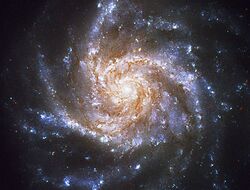Astronomy:NGC 1376
| NGC 1376 | |
|---|---|
 A Hubble Space Telescope (HST) image of NGC 1376 | |
| Observation data (J2000 epoch) | |
| Constellation | Eridanus |
| Right ascension | 03h 37m 05.80s[1] |
| Declination | −05° 02′ 36″[1] |
| Redshift | 0.013873±0.00003[1] |
| Distance | 180 Mly (55.1 Mpc)[2] |
| Apparent magnitude (V) | 12.1[2] |
| Characteristics | |
| Type | SA(s)cd[1] |
| Size | 71,000 ly |
| Apparent size (V) | 1.95 x 1.82[3] |
| Notable features | Older stars near core |
| Other designations | |
| IRAS 03346-0512,[1] MCG-01-10-011,[1] PGC 13352,[1] GSC 04722-00875[1] | |
NGC 1376 is a spiral galaxy located around 180 million light-years away in the constellation Eridanus.[1] It was discovered in 1785 by William Herschel, and it is 79,000 light-years across.[1] NGC 1376 is not known to have an active galactic nuclei, but it does have lots of star-forming regions.[2][3]
Characteristics
Concentrated along the spiral arms of NGC 1376, bright blue knots of gas highlight areas of active star formation.[4] These regions show an excess of light at ultraviolet (UV) wavelengths because they contain brilliant clusters of hot, newborn stars that are emitting UV light.[2] The less intense, red areas near the core and between the arms consist mainly of older stars.[4][2] The reddish dust lanes delineate cooler, denser regions where interstellar clouds collapse to form new stars.[1] Behind the spiral arms is a sprinkling of reddish background galaxies.[2]
NGC 1376 belongs to a class of spirals that are seen nearly face on from our line of sight.[1] Its orientation aids astronomers in studying details and features of the galaxy from a relatively unobscured vantage point.[2]
NGC 1376 is home to a supernova (SN 1990go)[2] that rivaled the brightness of the entire nucleus (as seen from ground-based telescopes) for several weeks. This was observed in 1990.[2][3]
References
- ↑ 1.00 1.01 1.02 1.03 1.04 1.05 1.06 1.07 1.08 1.09 1.10 1.11 "By Name | NASA/IPAC Extragalactic Database". http://ned.ipac.caltech.edu/byname?objname=NGC+1376&hconst=67.8&omegam=0.308&omegav=0.692&wmap=4&corr_z=1.
- ↑ 2.0 2.1 2.2 2.3 2.4 2.5 2.6 2.7 2.8 "Spiral galaxy NGC 1376" (in en). https://www.spacetelescope.org/images/opo1000a/.
- ↑ 3.0 3.1 3.2 "NGC 1376 - Spiral Galaxy in Eridanus | TheSkyLive.com". https://theskylive.com/sky/deepsky/ngc1376-object.
- ↑ 4.0 4.1 "NGC 1376 - Galaxy - SKY-MAP". http://www.wikisky.org/starview?object_type=2&object_id=3155.
External links
 |

